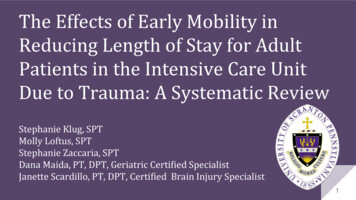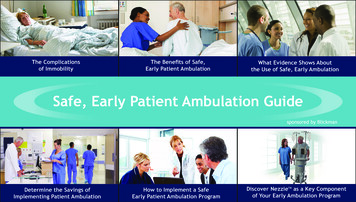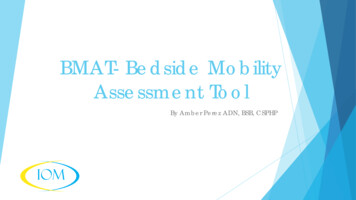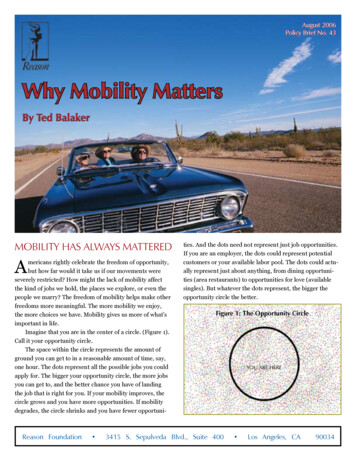
Transcription
The Effects of Early Mobility inReducing Length of Stay for AdultPatients in the Intensive Care UnitDue to Trauma: A Systematic ReviewStephanie Klug, SPTMolly Loftus, SPTStephanie Zaccaria, SPTDana Maida, PT, DPT, Geriatric Certified SpecialistJanette Scardillo, PT, DPT, Certified Brain Injury Specialist1
Sackett LevelResults7. Conclusion8. Clinical Relevance9. Limitations10.Future Research11.Take Home Message2
Patients in the ICU due to Trauma High risk for complications associated with immobility1 Extensive orthopedic and neurological injuries1 Difficult to mobilize these patients2 Lines and tubesMedical stabilitySedationSevere weakness3
Early Mobility No standard definition for the term “early”3 Safe intervention to decrease the negative effects of bed rest andpreserve ICU and hospital functional outcomes4 Early mobility programs typically consists of exercises that beginin bed and progress to the end goal of ambulation4 Typically beginning as soon as patients demonstrate sufficientphysiologic stability44
Early Mobility Contraindications Neurologic5 No response to verbalstimulation Elevated ICP Agitation requiring sedative Respiratory5 Inability to maintain SpO2 86% FiO2 0.6 or PEEP 12cmH20 RR 40breaths/min Circulatory5 MAP 60 mmHg or 115mmHg HR 120 bpm or 50bpm atrest Dysrhythmia requiringmedication Other5 Renal replacement therapy Unstable fractures Open abdomen5
Current Research in the ICU Six systematic reviews have found overall positive benefits ofearly mobility delivered in the ICU4 Early mobility has been shown to decrease ICU and hospitallengths of stay6 Importantly physical therapy can be performed safely forpatients who are critically ill76
PurposeTo determine if mobility is an effective intervention to reducelength of stay (LOS) for adult ( 18 y/o) patients in theIntensive Care Unit (ICU) due to trauma7
MethodsDatabasesCINAHL ProQuest Pubmed HealthSource:Nursing/Academic Edition 8
MethodsSearch terms(“Physical therapy” OR “physiotherapy”) AND (“IntensiveCare Unit” OR “ICU”) AND (“length of Stay” OR “LOS”) AND(“Trauma”) NOT (“Pediatric” OR “Neonatal”)9
MethodsSearch limitsEnglish language Published within past 10 years Peer-reviewed 10
MethodsSelection Criteria Patients in the ICU due to traumaAdults 18 yearsMobility performed as an interventionMeasures of hospital and ICU length of stay11
PRISMA12
Sackett LevelStudy DesignSackett Level ofEvidencePre and Post InterventionStudy4Clark DE et al- Effectiveness of an Early Mobilization Protocol ina Trauma and Burns Intensive Care Unit8Case Control Study3BGillick BT et al - Mobility criteria for upright sitting withpatients in the neuro/trauma intensive care unit: an analysis oflength of stay and functional outcomes9Case Control Study3BPandullo SM et al - Time for critically ill patients to regainmobility after early mobilization in the intensive care unit andtransition to a general inpatient floor6Retrospective Study4Sottile PD et al - Physical Therapist Treatment of Patients in theNeurological Intensive Care Unit7Retrospective Study4Author and TitleBooth K et al - Progressive Mobility Protocol Reduces VenousThromboembolism Rate in Trauma Intensive Care Patients113
Study Characteristics Sample sizes ranged from 30-2,167 participantsBoth males and females were includedAverage age range: 44.1-65 yearsSpecific setting Neuro/ Trauma ICU – 2Burn/Trauma ICU - 1Neurological ICU - 1General ICU- 114
Study Characteristics Continued 3 studies specified a classification system of mobilityprogression1,6,8 Amount of classifications ranged from 3 to 6 Lower levels performed PROM and bed mobility Higher levels performed transfers and ambulation15
Study Characteristics Continued 1 study utilized a progression program without defining levels7 Categorized as ROM, bed based interventions, transfers,standing, and ambulation 1 study performed an upright sitting program9 Participants were assisted from supine to upright sitting withlower extremities in a dependent position off the side of the bed16
Study Characteristics ContinuedPrimary OutcomesSecondary Outcomes Hospital Length ofStay1,6,7,8,9 Glasgow Coma Scale(GCS)7,9 ICU Length of Stay1,6,7,8,9 Injury Severity Scale(ISS)1,817
Author ofArticleMechanism ofInjuryResultsSpecific DiagnosisScaleUtilized forSeverity ofInjuryHospitalLOSICU LOSBooth etal1Not specifiedTBI, undefined tramaISSDecreasedDecreasedClark etal8Blunt trauma,Penetrating injury,BurnsSCI, fractureISSDecreasedDecreasedGillick etal9MVA, pedestrianinjury, gunshot,assaultSDH, EDH, cerebral edema,Pneumocephalus,Hydrocephalus,cerebellar infarctSCI, spine subluxationGCSDecreasedDecreasedPandulloet al6Not specifiedNot specifiedNot specifiedDecreasedDecreasedSottile etal7Not specifiedSAH, SDH, ICH, traumaGCSNotspecifiedNot specified18
ConclusionThere is weak to moderate evidence available on whetherearly mobilization affects length of stay in patients followingtrauma19
Conclusion Physical therapy was safely involved in the ICU care of allpatients following trauma Although not statistically significant, hospital and ICU LOSimproved in all studies to some degree20
Clinical RelevanceEarly mobility is a beneficial physical therapy intervention forpatients with trauma Safety Reduction in acute care stay Importance of PT involvement in early mobility protocol 21
Limitations Varied study designs Small sample sizes Limited definitions of protocols Definition of early mobility as a treatment Varied mechanism of injury22
Future Research Include long-term follow-up with larger sample size Identify a standard definition of early mobility Identify a standardized early mobility classification Identify effects of early mobility on quality of life23
Take Home MessageEarly mobility has been shown to decrease a patient’s hospitaland ICU length of stay in patients following trauma Utilizing early mobility as a treatment in the ICU is a safe andfeasible option for patients following a traumatic event toprevent the detrimental effects of bed rest Physical therapists play a vital role in implementing an earlymobility protocol as part of the interdisciplinary team 24
AcknowledgementsThank you! Dr. Dana Maida, PT, DPT, CGSDr. Janette Scardillo, PT, DPT, CBISDr. Tracey Collins, PT, PhD, MBA, GCSDr. John Sanko, PT, EdDDr. Renee Hakim, PT, PhD, NCSKelly BanyasDPT faculty & students25
References1.Booth K, Rivet J, Flici R, et al. Progressive Mobility Protocol Reduces Venous Thromboembolism Rate in Trauma Intensive Care Patients: A Quality Improvement Project .JTrauma Nurs. 2016;23(5):284-289. doi:10.1097/JTN.00000000000002342.Adler J, Malone D. Early Mobilization in the Intensive Care Unit: A Systematic Review. Cardiopulm Phys Ther J cranton.edu/login.aspx?direct true&db c8h&AN 104531139&site ehost-live. Accessed October 24, 2018.3.Mcwilliams D, Jones C, Atkins G, et al. Earlier and enhanced rehabilitation of mechanically ventilated patients in critical care: A feasibility randomised controlled trial. J CritCare. 2018;44:407-412. doi:10.1016/j.jcrc.2018.01.001.4.Krupp A, Steege L, King B. A systematic review evaluating the role of nurses and processes for delivering early mobility interventions in the intensive care unit. Intensive CritCare Nurs. 2018;47:30-38. doi:10.1016/j.iccn.2018.04.003.5.Fraser D, Spiva L, Forman W, Hallen C. Original Research: Implementation of an Early Mobility Program in an ICU. Am J Nurs. 7985.fc.6.Pandullo SM, Spilman SK, Smith JA, et al. Time for critically ill patients to regain mobility after early mobilization in the intensive care unit and transition to a generalinpatient floor. J Crit Care. 2015;30(6):1238-1242. doi:10.1016/j.jcrc.2015.08.0077.Sottile PD, Nordon-Craft A, Malone D, Luby DM, Schenkman M, Moss M. Physical Therapist Treatment of Patients in the Neurological Intensive Care Unit: Description ofPractice.Phys Ther; Washington. 2015;95(7):1006-1014.8.Clark DE, Lowman JD, Griffin RL, Matthews HM, Reiff DA. Effectiveness of an Early Mobilization Protocol in a Trauma and Burns Intensive Care Unit: A Retrospective CohortStudy. Phys Ther. 2013;93(2):186-196. doi:10.2522/ptj.201104179.Gillick BT, Marshall WJ, Rheault W, Stoecker J. Mobility criteria for upright sitting with patients in the neuro/trauma intensive care unit: an analysis of length of stay andfunctional outcomes. Neurohospitalist. 2011;1(4):172-177. doi:10.1177/194187441141511826
Questions?27
Pre and Post Intervention Study 4 Clark DE et al- Effectiveness of an Early Mobilization Protocol in a Trauma and Burns Intensive Care Unit8 Case Control Study 3B Gillick BT et al - Mobility criteria for upright sitting with patients in the neuro/trauma intensive care unit: an analysis of length of stay and functional outcomes9 Case Control .











